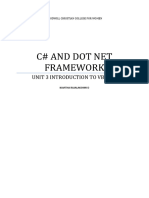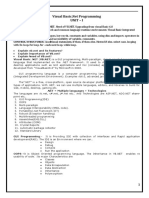Difference Between VB - Net and Visual Basic
Uploaded by
vitalis mainaDifference Between VB - Net and Visual Basic
Uploaded by
vitalis mainaDifference Between VB.
NET and Visual
Basic
VB.NET
VB.NET is also known as Visual Basic.NET. It stands for Visual Basic .Network Enabled
Technologies. It is a simple, high-level, object-oriented programming language developed by
Microsoft in 2002. It is a successor of Visual Basic 6.0, which is implemented on the Microsoft
.NET Framework. With this language, you can develop a fully object-oriented application that is
similar to an application created through another language such as C++, Java, or C#.
Feature of VB.NET
Inheritance (object-oriented language)
Delegates and events
Parameterized constructors
Method overloading/overriding
Type-safe
Delegates and events
Visual Basic
Visual Basic (VB) is a programming language developed by Microsoft in 1992. The purpose of
this language is to develop an application that can run on different versions of the Windows
operating system. A Visual Basic evolved from Basic Language; Basic language is easier to read
than other languages. The final version of Visual Basic was released in 1998. Microsoft then
launched a Visual Basic DotNet ('VB.NET') language, which is much better than Visual Basic in
all aspects such as performance, reliability, working environment, easy to build, and debugging
an application.
Features of Visual Basic
User Interface design
Rapid Application Development
Using this language, you can use internet or intranet services in your application.
It has powerful database access tools, by which you can easily develop front end
applications.
It also supports ActiveX technology, in which you can access the features of other
application in system application. For example: Microsoft Word, Microsoft Excel, etc.
Difference Between VB. NET and Visual Basic
VB .NET Visual Basic
It stands for Visual Basic. Network Enables It is a programming language developed
Technology. It is also developed by Microsoft, and this
by Microsoft for the fastest development
language was based on the .Net Framework.
of a window-based operating system as
Furthermore, it is specially designed for VB
well as applications.
developers.
VB is the predecessor of VB.NET and
It is a modern, fully object-oriented language that
was not an object-oriented language. So,
replaced VB6.
it is not actively maintained.
A VB.NET uses the Common Language Runtime
(CLR) component of .Net Framework at runtime. It has Visual Basic uses the VB-Runtime
better features and design implementation as compared environment.
to VB-Runtime.
It is a compiled language It is an Interpreter based language
It does not support backward compatibility. It supports backward compatibility.
It is a type-safe language. It is not a type-safe language.
Data Connectivity and handling are done
In VB.NET, data is handled using the ADO.net
through DAO, RDO, and ADO (ActiveX
protocol.
Data Object) protocol,
The Object support default property of
Object does not support default property.
virtual basic.
In VB, most of the parameters are passed
In the VB.Net parameter are passed by a default value.
by reference.
A Multithreaded application can be developed in It does not support the multithread
VB.NET. concept.
You might also like
- Difference Between VB - NET and Visual BasicNo ratings yetDifference Between VB - NET and Visual Basic2 pages
- Computer Programming 1 Bachelor of Science in Information TechnologyNo ratings yetComputer Programming 1 Bachelor of Science in Information Technology1 page
- What Is The Difference Between VB6 and VBNo ratings yetWhat Is The Difference Between VB6 and VB2 pages
- August 28, 2011 K10blogger Basic Programming Language: Advantages and Disadvantages of Visual BasicNo ratings yetAugust 28, 2011 K10blogger Basic Programming Language: Advantages and Disadvantages of Visual Basic20 pages
- What Is Event-Driven Programming?: COMP314/ACMP312/BIT201No ratings yetWhat Is Event-Driven Programming?: COMP314/ACMP312/BIT20186 pages
- PDF Version Quick Guide Resources Discussion: Job SearchNo ratings yetPDF Version Quick Guide Resources Discussion: Job Search81 pages
- I. OF Visual Basic: Visual Basic Is A Third-Generation Event-Driven Programming Language and Integrated DevelopmentNo ratings yetI. OF Visual Basic: Visual Basic Is A Third-Generation Event-Driven Programming Language and Integrated Development2 pages
- Features of VB. NET Programming LanguageNo ratings yetFeatures of VB. NET Programming Language2 pages
- Introduction DOT NET TECHNOLOGY: (RGPV/June2009)No ratings yetIntroduction DOT NET TECHNOLOGY: (RGPV/June2009)42 pages
- CIT 1101 Fundamentals of Computer Science and Its ApplicationsNo ratings yetCIT 1101 Fundamentals of Computer Science and Its Applications99 pages
- Advanced Java Programming 2075 QuestionpaperNo ratings yetAdvanced Java Programming 2075 Questionpaper1 page
- Advanced Java Programming 2076 QuestionpaperNo ratings yetAdvanced Java Programming 2076 Questionpaper1 page
- Why Animals Should Not Be Kept in The Zoo EssayNo ratings yetWhy Animals Should Not Be Kept in The Zoo Essay1 page
- Top Floor Publishing - Advanced Web Sites Made EasyNo ratings yetTop Floor Publishing - Advanced Web Sites Made Easy313 pages
- Kz01-Qa-pln-s4-Xxxx Installation Itp For Instrument SystemNo ratings yetKz01-Qa-pln-s4-Xxxx Installation Itp For Instrument System8 pages
- Popovic Et Al. 'Srebrenica Seven' Indictment (Srebrenica Genocide)No ratings yetPopovic Et Al. 'Srebrenica Seven' Indictment (Srebrenica Genocide)52 pages
- United States Patent (10) Patent No.: US 7.931,757 B2No ratings yetUnited States Patent (10) Patent No.: US 7.931,757 B214 pages
- Journal of Experimental Zoology Part A Comparative Experimental Biology - 2004 - Steinberg - Townes and Holtfreter 1955No ratings yetJournal of Experimental Zoology Part A Comparative Experimental Biology - 2004 - Steinberg - Townes and Holtfreter 19556 pages
- Uniform Probability Distribution Normal Probability Distribution Exponential Probability Distribution100% (1)Uniform Probability Distribution Normal Probability Distribution Exponential Probability Distribution29 pages
- TheLevelofSpendingHabitsamongAccountancyBusinessandManagementStudentsofTacurongNationalHighSchoolBasisforProgramIntervention PDFNo ratings yetTheLevelofSpendingHabitsamongAccountancyBusinessandManagementStudentsofTacurongNationalHighSchoolBasisforProgramIntervention PDF48 pages





























































































